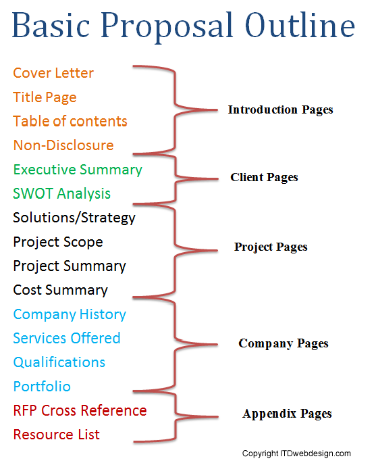RFP's, Proposals, and Contracts – Part 2
In Part 1 of this series we discussed the fundamental differences in the types of information requests we receive. In this article we will discuss the proposal writing process itself and how you can increase your chances of becoming the vendor of choice for potential clients.
Now that you have qualified your RFP, it’s time to begin the proposal writing process. There are some basic fundamental guidelines and elements of a proposal that should never be overlooked. We will outline the primary points of a general proposal below to help you to move from amateur freelancer to a more professional image. Keep in mind that proposals can be as short or as long as you want them to be. Just make sure you are providing all of the requested information in an easy to read format. Here are some of the pages that I believe every proposal should include as a bare minimum proposal foundation.
Basic Proposal Elements
Cover Letter – Always include a cover letter. Address the primary contact in a professional manner and thank them for the opportunity and consideration for vendor selection. Make sure that you mention that if there are any questions that you can be contacted via email or phone and provide those details. Keep it short and direct as this is only a cover letter and not a part of the main proposal content.
Title Page – The title page is mainly a graphical cover for the proposal that follows. This is your first page of the proposal itself and will usually contain your company name, logo, phone numbers and address. You should also include the proposal title, proposal and version numbers, and a basic description of the proposal.
You might be wondering why I mentioned proposal numbers and version numbers. Every proposal you create should have a unique proposal number assigned to it and also a version number appended to it. For example we use the following format for our proposals: 100-1 where 100 is the proposal number and the -1 indicates the version number of that proposal. This will allow you to keep track of version numbers of your proposal in case of any changes in the document that need to be referenced later in contracts or other external documentation. You will see how this works in Part 3 of this series when we talk about contracts in depth.
Table of Contents – Make sure you have an easy way for your proposal pages to be referenced.
Executive Summary – The executive summary is perhaps the most important document in your entire proposal. It may be the only section that a busy executive decision-maker reads. Be sure to summarize the most important aspects of the proposal here. This should be an overview of your entire proposal. Then use additional pages to go into deeper explanations of your proposal.
Project Scope – The project scope is one of your most valuable documents. This section of your proposal will serve a few purposes and will be the longest section of the proposal. First, the scope will become your project checklist. Each item should be explained in as much detail as possible. The reason that you should be so thorough with each requirement point is so that the client is aware of exactly what is being provided. This will also allow the client to make sure you understand their needs fully. And finally, the project scope will be referenced and become a part of your contract as we will discuss in Part 3 of this series.
Cost Summary – This is the page that will include the actual cost breakdowns and line items that you are charging for. This will also show the amount of hours you are quoting for and your price per hour.
Company Pages – Every proposal should also include some company information pages about the history or services that you offer. Consider this a perfect time to inform the client about additional services and products you offer that may not be included in your proposal. This is a great chance to upsell to the client and get additional work.
The diagram below is an outline of a basic proposal outline that includes additional pages for a larger project.

Upselling
Let’s talk about upselling for a moment. When I consult with other web development companies about their proposal writing practices and business best practices, upselling is usually one of the most underused resources to increase revenue.
FACT: Selling items and services separately will net you more income.
A study conducted by the automotive industry revealed the following:
If you were to purchase individual parts for a brand new $20,000.00 vehicle you would actually spend over $125,000.00 for just the parts. And that does not include assembly labor and paint.
All product manufacturing works this way. Web development services can easily adapt to work this way also. Sell separately where you can. Small items add up fast.
Items that you can charge extra for but normally don’t charge extra for or offer as an additional service.
|
|
More nuggets of knowledge
- Know that people looking for your services do not care as much about your abilities as much as they care about your ability to understand their needs. Listen to the client; they know their business better than you do. Having the ability to simply listen to the needs of the client can be the difference between getting the contract signed or not.
- Be direct and to the point. Use plain text explanations. Never try to make yourself sound intellectually superior by using big fancy words. Use plain language and explain things at a fifth grade reading level so that no matter who reads your proposal, it can be easily understood. Plain language (also called Plain English) is communication your audience can understand the first time they read or hear it. Language that is plain to one set of readers may not be plain to others.
- Make it look professional. Sometimes it’s not enough to have a great outline. If you enhance your proposal with some nice borders, outlines, and footers, your proposal will be more appealing to the reader and look much more professional.
Click here for an example proposal that contains most elements discussed in this article.
- NEVER over promise. The second that you over promise to a client is the second that you have begun to fail at the project. Do not over estimate what you can actually deliver to the client. The higher the client’s expectations, the more you have to live up to those expectations. If you are not confident in yourself that you can deliver everything that you promised, then you are surely setting yourself up to fail.
- Submit “Just In Time”. What does this mean? Well, this means that you should not submit your proposal until right before it is actually due. Why? Because things can change. If you are approached and the client has given a 30-day deadline to submit your proposal, and you are the first one to submit a proposal then this is a very bad thing that may have just cost you not only the project but a lot of time as well. Over that 30-day period there may be other vendors asking questions that you haven’t thought to ask, and the client may be getting some ideas and influences from others. So over that 30-day period it is likely that more information could become available that will affect your proposal. Also even if nothing changes and you wait until a couple of days before the due date your proposal will most likely be the most recent one received and be the most fresh proposal in the mind of the reader and possibly increase your chances of winning the contract.
- Price doesn’t matter when you know the budget. Budgets are just merely a guideline. They are not ever set in stone. Consider the fact that you may not be dealing with the primary decision maker of the company and the person you are dealing with could have just been given a number to work with as a starting point to benchmark the company’s realistic budget they can spend to see the project to completion. The budget can always be adjusted.
- Break out the project into phases can make the client into a long term client. If the initial budget is an issue, talk to the client about breaking up the project into phases. Whenever I use this tactic it usually ends up with the best results and the clients love this idea. It shows the client that you are willing to work with them on a long term basis and that you are flexible and considerate to their financial situation.
- ASK FOR THE JOB! Ever hear that old saying “if you don’t ask, you don’t get”? Show the client that you want the job by asking for it.
- Thank the prospect for the opportunity. This was also included in our cover letter however it is also good practice to also give thanks for the opportunity at the end of the proposal as well.
- Follow up and ask for feedback if you do not get the job. This can be extremely valuable information. Most potential clients will be more than happy to explain why you were not the selected vendor. However you have to ask properly and let them know that you are requesting this feedback so that you can improve your skills and grow your company. Do not get defensive and go back and forth with them about their feedback. Remember that you are asking for it, so you cannot take offense to any feedback they may provide you. Make sure you thank them for the information they have provided and leave it at that.
Make sure you join us next month for RFP's, Proposals, and Contracts – Part 3 where we will talk about contracts and how to protect yourself from liability when things go wrong with the client.
Some articles published on the Joomla Community Magazine represent the personal opinion or experience of the Author on the specific topic and might not be aligned to the official position of the Joomla Project
By accepting you will be accessing a service provided by a third-party external to https://magazine.joomla.org/
 Community Magazine
Community Magazine 
Comments